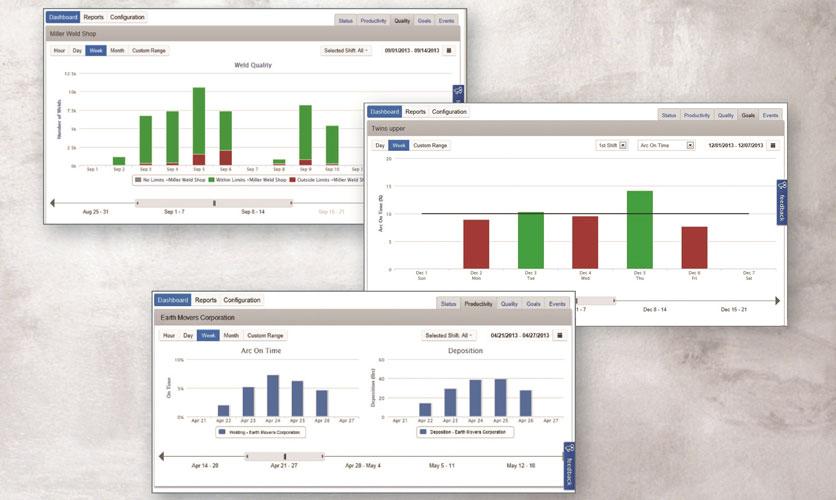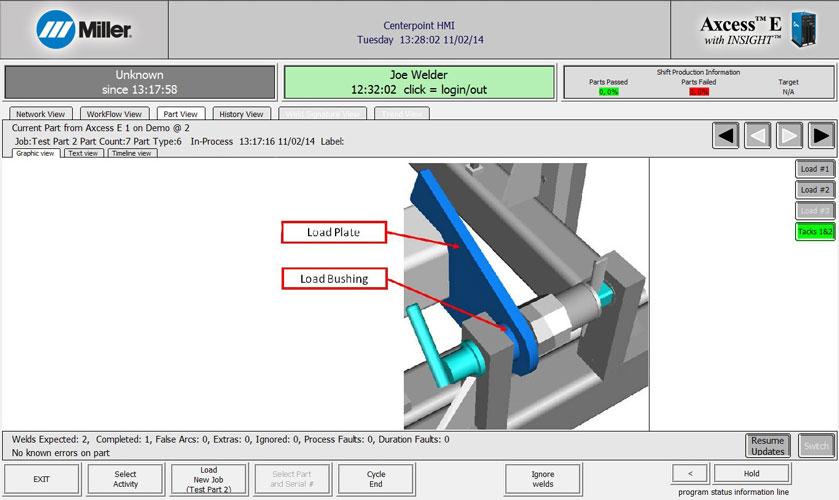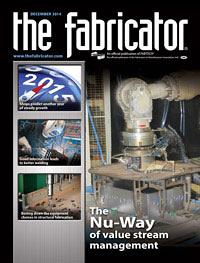Involved in Welding Information Management
- FMA
- The Fabricator
- FABTECH
- Canadian Metalworking
Categories
- Additive Manufacturing
- Aluminum Welding
- Arc Welding
- Assembly and Joining
- Automation and Robotics
- Bending and Forming
- Consumables
- Cutting and Weld Prep
- Electric Vehicles
- En Español
- Finishing
- Hydroforming
- Laser Cutting
- Laser Welding
- Machining
- Manufacturing Software
- Materials Handling
- Metals/Materials
- Oxyfuel Cutting
- Plasma Cutting
- Power Tools
- Punching and Other Holemaking
- Roll Forming
- Safety
- Sawing
- Shearing
- Shop Management
- Testing and Measuring
- Tube and Pipe Fabrication
- Tube and Pipe Production
- Waterjet Cutting
Industry Directory
Webcasts
Podcasts
FAB 40
Advertise
Subscribe
Account Login
Search
Managing welding information more efficiently
5 ways to drive continuous improvement with welding information management systems
- By Caleb Krisher and Todd McEllis
- December 16, 2014
- Article
- Arc Welding

Welding information management systems provide realtime, factual data that helps owners and managers identify and rectify production issues quickly.
Improving the efficiency of a welding operation depends largely on knowing what actually needs to change for a company to reach its goals.
It is difficult to increase productivity, improve quality, or reduce costs if there isn’t a solid starting point. It’s just as difficult to track the effectiveness of continuous improvement initiatives without a clear way to monitor the results.
Welding information management systems are a good option to drive change in the welding operation. At the highest level, these systems provide two key benefits:
- Real-time, factual data that helps owners and managers identify and rectify problems quickly
- The ability to measure the impact of continuous improvement efforts
Welding information management systems available today can range from basic to advanced and can be used in either semiautomatic or robotic applications. These systems eliminate the need for time-consuming manual data collection and analysis.
The decision of what type to implement depends on a company’s specific business strategies and goals. For example, an operation that welds large components with long cycle times needs different productivity metrics than one producing many small pieces throughout the day. These metrics can range from total arc-on time for the day for low-volume production to the number of parts produced for high-volume production.
Basic welding information management systems are designed to drive quality and productivity improvements primarily through the monitoring of arc-on time and deposition rates. Advanced systems do the same, but provide much more detailed feedback. They also give companies complete control over the entire fabrication and welding process, from loading fixtures to welding and postwelding activities.
When implementing any type of welding information management system, it’s critical to know the ways that data can be used to drive real change (see Figure 1). Here are five ways to drive continuous improvement using this technology.
1. Increase Productivity
Providing key information is one way an information management system can help to streamline a welding operation. This puts employees in a position to become much more productive.
But before a fabricator can improve welding productivity, it needs to know where to begin. Welding information systems can point managers in the right direction by providing answers to several questions:
- Which operators are the most productive, and which need additional training?
- Can a manufacturer handle more business without adding to its workforce?
- Are new hires achieving expected productivity and quality goals?
- How much arc-on time does each welder have? (If a company’s welding operators have 15 percent arc-on time daily, which is typical for semiautomatic manual welding, managers definitely need to find out what is happening during the remaining 85 percent of the welders’ day, which could open the door to giant strides in productivity.)
- If welding operators are retiring, can the remaining staff maintain the same level of productivity in the future, or will new hires be necessary?
Basic welding information management systems provide the data to answer those questions in three ways: tracking arc-on time, deposition amounts, and deposition rates. This monitoring allows management to assess how productive an employee is on an hourly, daily, weekly, and monthly basis and to identify any inconsistencies among the workforce. The assessment is made by tracking how much time each welding operator spends welding, as well as how much filler metal he or she deposits over a given period of time. Filler metal deposition rates are calculated automatically by taking into account four variables on every weld made: wire feed speed, density of the filler metal wire, diameter of the wire, and duration of each weld.

Figure 1
Through reports provided by welding information management systems, manufacturers can garner data to increase productivity, improve quality, and gain an understanding of the true cost of welding.
Advanced welding information management systems can track the actual number of parts produced per operator in a given timeframe to determine the opportunity for productivity improvements. They also provide weld sequence controls so that the welding operator welds the part in the correct order and in the most efficient manner possible.
2. Improve Weld Quality
Quality begins in the weld cell, but its impact is far-reaching. The farther down the production line a defective part moves, the more expensive it becomes to fix.
The goal in any welding operation should be to identify and rectify quality issues as soon as they occur. Early identification helps reduce rework, as well as potential warranty issues or safety concerns should the faulty part enter into service. Ensuring the highest weld quality plays a significant role in growing and preserving brand reputation in markets where manufacturers compete for customer loyalty.
Basic welding information systems can identify out-of-spec welds according to the welding procedure. Specifically, they monitor amperage, volts, and wire feed speeds. This monitoring shows whether an operator is welding within a threshold capable of producing the desired weld and meeting quality standards. These systems will alert management if the operator is welding outside the correct parameter thresholds to prompt investigation, determine root cause, and implement corrective action.
Advanced welding information management systems offer step-by-step, weld-by-weld guidance to the welding operator via a human-machine interface (HMI). They ensure welds are made in sequence to prevent part distortion or other quality problems and missed welds. Administrators can configure the system so that each weld has its own set of thresholds for various welding parameters, including current and voltage, wire feed speed, gas flow, weld duration, and deposition.
If any aspect of the process is out of range, these systems can alert the welding operator and/or management to the problem. In some cases, the system can be set up to pause until the issue has been rectified, thereby preventing a poor-quality part from leaving the weld cell.
Again, the system’s response will depend on the company’s needs, the products it produces, and the liability associated with poor weld quality. All of these factors determine which level of data and control will be necessary from a welding information management system.
3. Identify and Reduce Costs
Companies can gain a greater understanding of the real cost of welding through the collection of rich data (see Figure 2). This information can help when quoting jobs by giving companies an accurate assessment of how much it costs to produce a part. It also can assist in identifying cost trends over a period of time so a company can determine when intervention is required.
Basic welding information management systems are capable of tracking how much arc-on time is necessary to produce a part, providing a clearer assessment and understanding of existing labor costs. These systems also can track filler metal usage to determine the cost per weldment and to identify instances of over- or underwelding. Using too much filler metal adds unnecessary costs. Using too little may compromise a weldment’s integrity.
Advanced welding information management systems have built-in cost calculators that take into account cycle time (labor), filler metal (cost per pound), shielding gas usage, and the amount of electricity required to complete the part. They also can track costs over time to spot trends. By identifying every aspect of the welding process, advanced monitoring can give companies insight into whether it would be more cost-effective to use a new process or wire.

Figure 2
Advanced welding information management systems allow companies to determine the actual time and cost to make a part, taking into account all aspects of the preweld, weld, and postweld operation.
4. Train Operators to Weld Consistently
The goal of training via a welding information system is to teach a consistent technique that supports good weld quality and productivity and helps to minimize costs.
Basic welding management systems offer limited capabilities when it comes to training. They can identify when a welding operator is welding outside of preset thresholds, which gives management a general indication of where training might be needed. This intervention typically would be conducted away from the production weld cell.Advanced welding information management systems offer more in-depth training opportunities right within the weld cell. Using an HMI within the cell, they take the welding operator through the entire fabrication and welding process, providing nonwelding and welding instructions. Companies can set up work procedures using photos, drawings, or videos. More specifically, advanced welding information management systems can provide guidance on selecting the correct components, choosing the appropriate fixture based on the part to be welded, setting up and loading the fixture, preweld part prep, welding sequence, midstream part movements, postweld cleanup, and quality assurance inspection.
Should an error occur during one of these steps, the system can alert the operator, enabling him to make the appropriate corrections himself or with the help of a supervisor or weld inspector. The end result is faster training, which ultimately supports better welding quality and productivity.5. Manage Nonwelding Activities
Gaining and maximizing efficiency in a welding operation requires looking beyond just the weld cell to manage nonwelding activities. Identifying upstream and downstream bottlenecks can prevent downtime that negatively affects the effectiveness of a weld cell.
In many cases, 85 percent of a welding operator’s time is spent with nonwelding activities. If a company can increase arc-on time from 15 percent to 20 percent, it will gain a 33 percent increase in welding output (if all other variables remain the same, such as wire feed speed).
As with training capabilities, basic welding information management systems are limited in identifying nonwelding activities. However, very inconsistent arc-on time and deposition rates may indicate that excessive, unplanned downtime needs to be addressed.
Conversely, advanced welding information management systems assist companies in documenting and analyzing reasons for downtime. For instance, the system can compare downtime among multiple weld cells/welding operators to determine if consistent, recurring interruptions are a problem. Reasons for interruptions could be:
- Welders are waiting for parts delivery.
- Incorrect parts have been delivered.
- Defective parts don’t meet spec, requiring custom fit-up.
- Downtime is needed for equipment maintenance or repair.
- Time is spent waiting for or executing inspection and maintenance.
- Downstream delays in production prevent starting a new weldment.
This in-depth information gathering allows management to assess trends in nonwelding activities to determine if they are legitimate or should be challenged.
The Commitment and Payoff
Welding information management systems require an upfront investment, as well as a commitment to incorporate the information into the company’s normal day-to-day operations. For a fabricator dedicated to continuous improvement, this type of investment can result in long-term benefits.
When considering the implementation of either a basic or advanced welding information management system, companies should always take into account their business strategies to determine the level of data necessary to drive continuous improvement. A welding equipment manufacturer or trusted welding distributor often can offer an assessment of the welding operation to guide the decision.
About the Authors
Caleb Krisher
1635 W. Spencer St.
Appleton, WI 54912
920-734-9821
Todd McEllis
Involved in Welding Information Management
1635 W. Spencer St.
Appleton, WI 54912
920-734-9821
Related Companies
subscribe now

The Fabricator is North America's leading magazine for the metal forming and fabricating industry. The magazine delivers the news, technical articles, and case histories that enable fabricators to do their jobs more efficiently. The Fabricator has served the industry since 1970.
start your free subscription- Stay connected from anywhere

Easily access valuable industry resources now with full access to the digital edition of The Fabricator.

Easily access valuable industry resources now with full access to the digital edition of The Welder.

Easily access valuable industry resources now with full access to the digital edition of The Tube and Pipe Journal.
- Podcasting
- Podcast:
- The Fabricator Podcast
- Published:
- 04/16/2024
- Running Time:
- 63:29
In this episode of The Fabricator Podcast, Caleb Chamberlain, co-founder and CEO of OSH Cut, discusses his company’s...
- Trending Articles
Tips for creating sheet metal tubes with perforations

Supporting the metal fabricating industry through FMA

JM Steel triples capacity for solar energy projects at Pennsylvania facility

Fabricating favorite childhood memories

Omco Solar opens second Alabama manufacturing facility

- Industry Events
16th Annual Safety Conference
- April 30 - May 1, 2024
- Elgin,
Pipe and Tube Conference
- May 21 - 22, 2024
- Omaha, NE
World-Class Roll Forming Workshop
- June 5 - 6, 2024
- Louisville, KY
Advanced Laser Application Workshop
- June 25 - 27, 2024
- Novi, MI


























